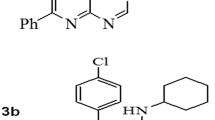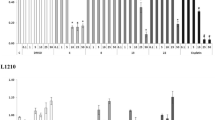Summary
3,4-dihydro-6-[4-(3,4-dimethoxybenzoyl)-1-piperazinyl]-2(1H)-quinolinone (OPC-8212) is a quinolinone derivative with positive inotropic properties.
In order to elucidate the effect of OPC-8212 on the haemopoietic system we studied its in vitro effect on bone-marrow progenitor cells (granulocyte/monocyte colonyforming units [CFU-GM] and erythroid burst-forming units [BFU-E]), on the proliferation and secretion of granulocyte/monocyte colony-stimulating factor (GM-CSF) and interferon-γ (IFN-γ) by peripheral lymphocytes, and on GM-CSF secretion by fibroblasts from healthy individuals. The dose-effect relations of OPC-8212 on CFU-GM proliferation and on lymphocytic GM-CSF secretion showed no effect at very low drug concentrations, with a threshold at the lower end of the therapeutic range and highly significant dose-dependent inhibition at concentrations above that threshold. BFU-E, peripheral lymphocyte proliferation and lymphocytic IFN-γ secretion were depressed, although to a lesser extent, in a linear dose-dependent fashion. OPC-8212 did not affect GM-CSF secretion by one strain of fibroblasts but reduced it at higher concentrations in assays with another strain of cells. We conclude that direct toxic effects on bone-marrow progenitor cells, in combination with the inhibition of cytokines involved in the regulation of haemopoiesis in certain susceptible individuals, may be responsible for idiosyncratic reactions to OPC-8212.
Similar content being viewed by others
References
Tominaga M, Yo E, Ogawa H, Yamashita S, Yabuuchi Y, Nakagawa K (1984) Studies on positive inotropic agents. I. Synthesis of 3,4-dihydro-6-[4-(3,4-dimethoxybenzoyl)-1-piperazinyl]-2(1H)-quinolinone and related compounds. Chem Pharma Bull 32: 2100–2110
Yamashita S, Hosokawa T, Kojima M, Mori T, Yabuuchi Y (1984) In vitro and in vivo studies of 3,4-dihydro-6-[4-(3,4-dimethoxybenzoyl)-1-piperazinyl]-2(1H)-quinolinone (OPC-8212), a novel positive inotropic drug, in various animals. Arzneimittelforschung/Drug Research 34: 342–346
Inoue M, Hori M, Nakajima S, Kitakaze M, Fukunami M, Ishida Y, Abe H (1984) Effects of 3,4-dihydro-6-[4-(3,4-dimethoxybenzoyl)-1-piperazinyl]-2(1H)-quinolinone (OPC-8212), a new inotropic agent, on cardiotonic activity and coronary hemodynamics. Arzneimittelforschung/Drug Research 34: 355–359
Lathrop DA, Schwartz A (1984) Electro-mechanical effects of 3,4-dihydro-6-[4-(3,4-dimethoxybenzoyl)-1-piperazinyl]-2(1H)-quinolinone (OPC-8212), a new positive inotropic agent. Isolated adult Purkinje strands and ventricular trabeculae. Arzneimittelforschung/Drug Research 34: 371–375
Lathrop DA, Varro A, Schwartz A (1989) Rate-dependent electrophysiological effects of OPC-8212: comparison to sotalol. Eur J Pharmacol 164: 487–496
Feldman AM, Becker LC, Llewellyn MP, Baughman KL (1988) Evaluation of a new inotropic agent, OPC-8212, in patients with dilated cardiomyopathy and heart failure. Am Heart J 116: 771–777
Yatani A, Imoto Y, Schwartz A, Brown AM (1989) New positive inotropic agent OPC-8212 modulates single Ca+2 channels in ventricular myocytes of guinea pig. J Cardiovasc Pharmacol 13: 812–819
Ijima T, Taira N (1987) Membrane current changes responsible for the positive inotropic effect of OPC-8212, a new positive inotropic agent, in single ventricular cells of the guinea pig heart. J Pharmacol Exp Ther 240: 657–662
Endoh M, Yanagisawa T, Taira N, Blinks JR (1986) Effects of new inotropic agents on cyclic nucleotide metabolism and calcium transients in canine ventricular muscle. Circulation 733: III 117–133
Rapundalo ST, Lathrop DA, Harrison SA, Beavo JA, Schwartz A (1988) Cyclic AMD-dependent and cyclic AMP-independent actions of a novel cardiotonic agent, OPC-8212. Arch Pharmacol 338: 692–698
Taira N, Endoh M, Iijima T, Satoh K, Yanagisawa T, Yamashita S, Maruyama M, Kawada M, Morita T, Wada Y (1984) Mode and mechanism of action of 3,4-dihydro-6-[4-(3,4-dimethoxybenzoyl)-1-piperazinyl]-2(1H)-quinolinone (OPC-8212), a novel positive inotropic drug, on the dog heart. Arzneimittelforschung/Drug Research 34: 347–355
Metcalf D, Merchav S, Wagemaker G (1982) Commitment by GM-CSF of M-CSF of bipotential GM progenitor cells to granulocyte or macrophage formation. In: Baum, Ledney and Thierfelder (eds) Experimental haematology today. Karger, Basel, pp 3–9
Burgess AW, Wison EMA, Metcalf D (1977) Stimulation by human placental conditioned medium of hemopoietic colony formation by human bone-marrow cells. Blood 49: 573–583
Brattig NW, Diao GJ, Berg PA (1988) The specificity of the lymphocyte transformation test in a patient with hypersensitivity reactions to pyrazolone compounds. A 10-week follow-up study before and after rechallenge. Eur J Clin Pharmacol 35: 39–45
Schultze JL, Stettin A, Berg PA (1991) Demonstration of specifically sensitized lymphocytes in patients treated with an aqueous mistletoe extract (Viscum album L.). Klin Wochenschr 69: 397–403
Heimpel H (1988) Drug-induced agranulocytosis. Med Toxicol Adverse Drug Exp 3: 449–462
Young GAR, Vincent PC (1980) Drug-induced agranulocytosis. Clin Haematol 9: 483–504
Dexter TM, Spooncer E (1987) Growth and differentiation in the hemopoietic system. Ann Rev Cell Biol 3: 423–441
Zoumbos NC, Djeu JY, Young NS (1984) Interferon is the suppressor of hematopoiesis generated by stimulated lymphocytes in vitro. J Immunol 133: 769–774
Brockbank KGM, DeJong JP (1987) Hemopoiesis on skin-derived fibroblasts in vitro. Leukemia 1: 609–612
Eliason JF, Thorens B, Kindler V, Vassalli P (1988) The roles of granulocyte-macrophage-stimulating factor and IL-3 in stromal cell-mediated hemopoiesis in vivo. Exp Hematol 16: 307–312
Kulessa W, Becker EW, Berg PA (1992) Wiederholte Agranulozytose nach Einnahme von Calciumdobesilat. Dtsch Wochenschr 10: 372–374
Pisciotta AV (1973) Immune and toxic mechanisms in drug-induced agranulocytosis. Sem Hematol 10: 279–310
Idänpään HJ, Alhava E, Olkinuora M, Palva IP (1977) Agranulocytosis during treatment with clozapine. Eur J Clin Pharmacol 11: 193–198
Young GAR, Vincent PC (1980) Drug-induced agranulocytosis. Clin Haematol 9: 483–503
Somekh E, Douer D, Shaked N, Rubinstein E (1988) In vitro effects of ciprofloxacin and pefloxacin on growth of normal human hematopoietic progenitor cells and on leukemic cell lines. J Pharmacol Exp Ther 248: 415–418
Wiberg JJ, Nuttall FQ (1972) Methimazole toxicity from high doses. Ann Intern Med 77: 414–416
Gallicchio VS, Hulette BC (1989) In vitro effect of lithium on carbamazepine-induced inhibition of murine and human bone-marrow-derived granulocyte-macrophage, erythroid, and megakaryocyte progenitor stem cells (42837). Proc Soc Exp Med Biol 190: 109–116
Matsuzaki M, Tokioka T, Suga K, Sueoka E, Ono K, Sano M, Shimamoto Y, Yamaguchi M (1990) [Phenytoin induced agranulocytosis: direct and T cell-mediated mechanisms]. Rinsho-Ketsueki 31: 474–478
Boogaerts MA, Peters M, Peerman C, Kesteloot H, Verwilghen RL (1984) Mechanism of aprindine induced agranulocytosis: direct toxicity on CFU-C and CFU-GEMM. Scand J Haematol 32: 175–178
Kelton JG, Huang AT, Mold N, Logue GL, Rosse WF (1979) The use of in vitro techniques to study drug induced pancytopenia. New Engl J Med 301: 621–624
Sommadossi J-P, Carlisle R (1986) Toxicity of 3′-azido-3′-deoxythymidine and 9-(1,3-dihydroxy-2-propoxymethyl)guanine for normal human hematopoietic progenitor cells in vitro. Antimicrob Agents Chemother 31: 452–454
Huhn D (1980) Medikamentös induzierte Störungen der Hämatopoese. Dtsch Med Wochenschr 105: 1576–1581
Vincent PC (1986) Drug-induced aplastic anaemia and agranulocytosis. Incidence and mechanisms. Drugs 31: 52–63
Mathews KP (1984) Clinical spectrum of allergic and pseudoallergic drug reactions. J Allerg Clin Immunol 74: 558–566
Kallos P, West GB (1983) Pseudo-allergic reactions in man. In Turner P, Shand DG (eds) Recent Advances in Clinical Pharmacology 3, Churchill Livingstone, Edinburgh, pp 235–252
Ohnishi A, Ishizaki T (1988) Pharmacokinetic profile of OPC-8212 in humans: a new, nonglycosidic, inotropic agent. J Clin Pharmacol 28: 719–726
Author information
Authors and Affiliations
Rights and permissions
About this article
Cite this article
Busch, F.W., Tillmann, A., Becker, E.W. et al. The inhibitory effects of a positive inotropic quinolinone derivative, 3,4-dihydro-6-[4-(3,4-dimethoxybenzoyl)-1-piperazinyl]-2(1H)-quinolinone (OPC-8212), on bone-marrow progenitor cells and peripheral lymphocytes. Eur J Clin Pharmacol 42, 629–633 (1992). https://doi.org/10.1007/BF00265927
Received:
Accepted:
Issue Date:
DOI: https://doi.org/10.1007/BF00265927




